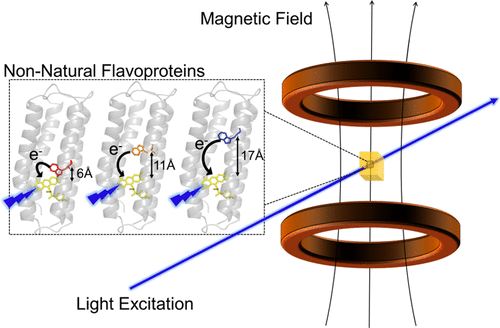当前位置:
X-MOL 学术
›
J. Am. Chem. Soc.
›
论文详情
Our official English website, www.x-mol.net, welcomes your
feedback! (Note: you will need to create a separate account there.)
Magnetically sensitive radical photochemistry of non-natural flavoproteins
Journal of the American Chemical Society ( IF 14.4 ) Pub Date : 2018-06-25 , DOI: 10.1021/jacs.8b03104 Tilo M. Zollitsch 1 , Lauren E. Jarocha 1 , Chris Bialas 2 , Kevin B. Henbest 3 , Goutham Kodali 2 , P. Leslie Dutton 2 , Christopher C. Moser 2 , Christiane R. Timmel 3 , P. J. Hore 1 , Stuart R. Mackenzie 1
Journal of the American Chemical Society ( IF 14.4 ) Pub Date : 2018-06-25 , DOI: 10.1021/jacs.8b03104 Tilo M. Zollitsch 1 , Lauren E. Jarocha 1 , Chris Bialas 2 , Kevin B. Henbest 3 , Goutham Kodali 2 , P. Leslie Dutton 2 , Christopher C. Moser 2 , Christiane R. Timmel 3 , P. J. Hore 1 , Stuart R. Mackenzie 1
Affiliation

|
It is a remarkable fact that ∼50 μT magnetic fields can alter the rates and yields of certain free-radical reactions and that such effects might be the basis of the light-dependent ability of migratory birds to sense the direction of the Earth's magnetic field. The most likely sensory molecule at the heart of this chemical compass is cryptochrome, a flavin-containing protein that undergoes intramolecular, blue-light-induced electron transfer to produce magnetically sensitive radical pairs. To learn more about the factors that control the magnetic sensitivity of cryptochromes, we have used a set of de novo designed protein maquettes that self-assemble as four-α-helical proteins incorporating a single tryptophan residue as an electron donor placed approximately 0.6, 1.1, or 1.7 nm away from a covalently attached riboflavin as chromophore and electron acceptor. Using a specifically developed form of cavity ring-down spectroscopy, we have characterized the photochemistry of these designed flavoprotein maquettes to determine the identities and kinetics of the transient radicals responsible for the magnetic field effects. Given the gross structural and dynamic differences from the natural proteins, it is remarkable that the maquettes show magnetic field effects that are so similar to those observed for cryptochromes.
中文翻译:

非天然黄素蛋白的磁敏自由基光化学
一个值得注意的事实是,~50 μT 的磁场可以改变某些自由基反应的速率和产量,并且这种影响可能是候鸟依赖光来感知地球磁场方向的能力的基础。这种化学罗盘的核心最有可能的感觉分子是隐花色素,这是一种含有黄素的蛋白质,经过分子内蓝光诱导的电子转移,产生磁敏感的自由基对。为了更多地了解控制隐花色素磁性敏感性的因素,我们使用了一组从头设计的蛋白质模型,这些蛋白质模型自组装为四-α-螺旋蛋白质,结合单个色氨酸残基作为电子供体放置大约 0.6, 1.1 ,或 1。距离作为发色团和电子受体共价连接的核黄素 7 nm。使用专门开发的腔衰荡光谱形式,我们对这些设计的黄素蛋白模型的光化学进行了表征,以确定负责磁场效应的瞬态自由基的特性和动力学。鉴于与天然蛋白质的总体结构和动态差异,值得注意的是,模型显示出与隐花色素观察到的磁场效应非常相似的磁场效应。
更新日期:2018-06-25
中文翻译:

非天然黄素蛋白的磁敏自由基光化学
一个值得注意的事实是,~50 μT 的磁场可以改变某些自由基反应的速率和产量,并且这种影响可能是候鸟依赖光来感知地球磁场方向的能力的基础。这种化学罗盘的核心最有可能的感觉分子是隐花色素,这是一种含有黄素的蛋白质,经过分子内蓝光诱导的电子转移,产生磁敏感的自由基对。为了更多地了解控制隐花色素磁性敏感性的因素,我们使用了一组从头设计的蛋白质模型,这些蛋白质模型自组装为四-α-螺旋蛋白质,结合单个色氨酸残基作为电子供体放置大约 0.6, 1.1 ,或 1。距离作为发色团和电子受体共价连接的核黄素 7 nm。使用专门开发的腔衰荡光谱形式,我们对这些设计的黄素蛋白模型的光化学进行了表征,以确定负责磁场效应的瞬态自由基的特性和动力学。鉴于与天然蛋白质的总体结构和动态差异,值得注意的是,模型显示出与隐花色素观察到的磁场效应非常相似的磁场效应。











































 京公网安备 11010802027423号
京公网安备 11010802027423号